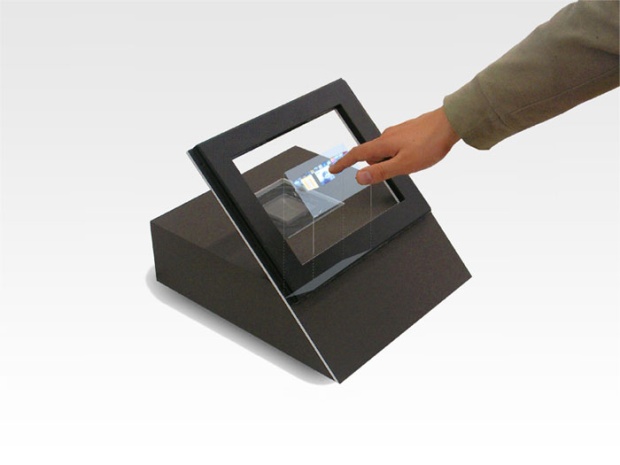National Institute of Information and Communications Technology (NICT) has developed a “Floating Touch Display” that can be used to interact with floating images. This is based on an optical device, also developed at NICT and capable of forming real, that is, no virtual mirror images in the air. With this development, it becomes possible to manipulate, with the fingers, extremely realistic images that appear floating in the air.
Home > Press Release > National Institute of Information and Communications Technology Development of a Floating Touch Display for Interfacing with Floating Images
National Institute of Information and Communications Technology Development of a Floating Touch Display for Interfacing with Floating Images
— With your finger, you can move images appearing in the air, that seem real, although nothing is there —
At NICT, one of our research goals is the creation of universal interface technology, to help achieve a future intellectual and living environment that is enjoyable to everyone. One component technology which we are developing is communication using floating images. Floating image systems which have been proposed so far have suffered from problems with visibility from different directions, or with resolution; also, with presenting the floating image above a plane surface. Because of these problems, the feeling of reality of the floating images have been poor, and not worth of building into an interactive system. Now, NICT has combined a new optical device with an infrared touch panel, resulting in an interactive system, which makes it possible that the user manipulate highly realistic floating images with fingertips.
The new 'Floating Touch Display' has the following components: an optical device developed at NICT, which is laid down horizontally; an infrared touch panel (without its glass face) placed above the optical device; and a flat LCD screen placed below the optical device. The floating image of the LCD screen appears in the plane of the touch panel, where the user can 'touch' it. By sensing the position and movement of the fingers, the floating image can be operated as if the user really touched it. Although there is no sensation of actual touch, the resulting experience is compelling.
With this technology, touch displays might become available for instance in medical situations where the fingers must not come into contact with contaminants; or for cooks with food traces on their hands. Also, because of the high reality of the floating images, we expect this technology to be very useful as a new medium of communication. However, at present the small size of the optical device limits the size of the floating image. This is not a fundamental limitation, only the result of the current manufacturing method, and we expect to overcome it. Our goal is to achieve a floating image size equivalent to a human body in 3 years.
This "Floating Touch Display" is exhibited at NAB2009 (http://www.nabshow.com/) in Las Vegas, during Apr. 20 - Apr. 23.

Technical Contact
Satoshi MAEKAWA
Tel :+81-774-98-6891
E-mail: 

















Public Relations
Sachiko HIROTA
Public Relations Office
Strategic Planning Department
Tel:+81-42-327-6923
Fax:+81-42-327-7587
E-mail: 

























